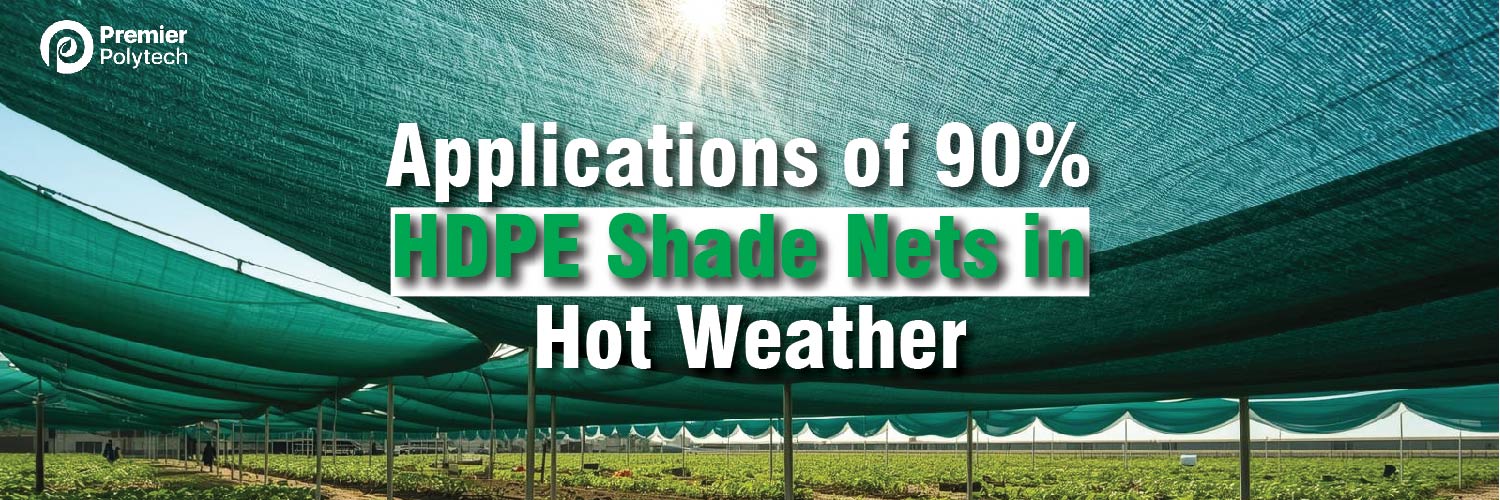
When it comes to protecting crops or any outdoor activity from extreme heat and scorching sunlight, a standard shade net is often insufficient. The 90% HDPE (High-Density Polyethylene) Shade Net is specifically designed to meet this challenge.
This high-density mesh blocks up to 90% of solar radiation, creating a deep, cool microclimate beneath the structure. While 30% or 50% nets are common for general vegetables, the 90% net is a specialized solution reserved for applications demanding maximum shade, cooling, and UV protection.
This article explores the primary applications and benefits of 90% HDPE shade nets, particularly in regions experiencing intense, hot weather.
The use of 90% shade nets in agriculture is crucial for specific crops or stages that require the highest degree of protection:
Protecting Delicate Stages: Small, tender seedlings emerging after germination are incredibly sensitive to intense sunlight. A 90% shade net prevents them from getting sun-scorched and drying out quickly.
Hardening Stage: In very hot climates, plants are often placed under 75% to 90% netting before field transplantation (hardening) to allow them to gradually acclimatize to the harsher outdoor environment.
Shade-Loving Plants: Specific crops like Orchids, Ferns, and certain ornamental plants naturally require very low light levels. In hot weather, the 90% net provides the near-darkness necessary for their optimal growth.
Darkness Requirement: Mushrooms thrive in cool, dark conditions. A 90% shade net helps maintain the necessary light reduction and temperature control in outdoor mushroom sheds.
Leafy Greens and Root Crops: In extremely hot weather, leafy vegetables like Spinach and Lettuce, and certain root crops, can be prone to “bolting” (flowering prematurely) or becoming bitter due to high heat stress. Using a 90% net can mitigate this stress and improve quality.
90% shade nets are highly popular outside of farming, where maximum coverage and a physical barrier are the primary requirements.
Preventing Heat Stress: High temperatures cause ‘Heat Stress’ in cattle, goats, and poultry, leading to reduced milk production, egg laying capacity, and fertility.
Maximum Cooling: By using 90% nets over cattle sheds and poultry houses, maximum shade is provided, keeping the ambient temperature at a tolerable level for the animals. This is critical for maintaining their productivity and health.
Worker Shade: 90% nets are used to cover scaffolding and temporary rest areas on construction sites to protect workers from intense sun and heat, significantly reducing the risk of heat stroke.
Dust Control and Privacy: The high density helps contain dust, debris, and construction materials from spreading. It also acts as an effective visual barrier, maintaining site privacy.
Vehicle Cooling: In hot regions, 90% shade nets are ideal for carports and parking lots. The net dramatically reduces the internal temperature of the car by blocking direct solar radiation.
Protection from UV Damage: It shields the vehicle’s paint, dashboards, and plastic trim from UV damage (fading and cracking), thus extending the vehicle’s lifespan.
Privacy Screens: On balconies, patios, and fences, 90% netting acts as an effective privacy screen while also reducing harsh wind and dust infiltration.
Recreational Areas: It is used to shade children’s playgrounds, swimming pool areas, and outdoor seating for cafes, making these spaces cool and comfortable during peak summer hours.
The HDPE material combined with its high shade density makes this net uniquely effective:
| Benefit | Description |
| Maximum Cooling | 90% shade means minimal light penetration, resulting in a noticeably lower temperature beneath the structure compared to lower-density nets. |
| Superior UV Protection | The HDPE material includes UV stabilizers, and the 90% density virtually blocks all harmful UV-A and UV-B radiation. |
| High Durability | Due to the high density and close knitting, this net is more resistant to tearing, fraying, and damage caused by strong winds. |
| Water Conservation | Intense shading reduces the rate of evaporation from the soil and plants, leading to a reduction in irrigation frequency and water consumption. |
| Multi-Purpose Use | Its high shade value makes it indispensable across agricultural, industrial, and residential sectors for specialized protective needs. |
The 90% HDPE shade net is a specialized tool designed not for general agriculture, but for applications that demand extreme heat mitigation, intense sun protection, and specialized security. Whether you are saving delicate seedlings, protecting livestock from heat stress, or keeping construction workers safe, the 90% net offers a powerful, durable, and essential solution.
A: No. A 90% shade net provides too much shade for most common vegetables (like tomatoes, peppers, cabbage), which can inhibit their growth and fruiting process (photosynthesis). Vegetables typically thrive under 30% to 50% shade. The 90% net is mainly reserved for the nursery stage or shade-loving leafy greens in extreme heat.
A: The choice of color depends on the objective:
Black: Provides the deepest shade and maximum temperature reduction, making it popular for livestock shelters and parking.
White: Diffuses the light and reflects more heat, which can be better for delicate plants in extremely hot conditions.
A: This depends on the area’s humidity and ventilation, but in a properly ventilated setup, the net can reduce the temperature by 5°C to 10°C (or 10°F to 18°F) compared to the outside ambient temperature, making the inner environment significantly more comfortable.
A: No. HDPE shade net is knitted mesh, meaning it allows water to pass through. It lets rainwater reach the plants while reducing the size of the droplets to prevent physical damage. It is not fully waterproof.
For more than 5+ years we have been delivering world-class construction and we’ve built many lasting relationships along the way.
© 2025 Premier Polytech All Rights Reserved.